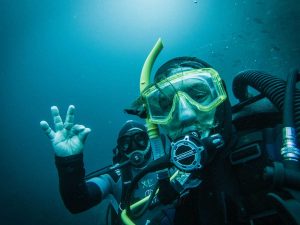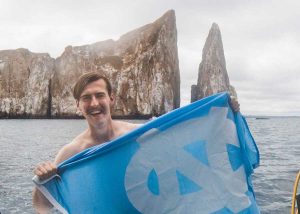Jackson Seymore
Jackson Seymore ’20 is a Chemistry major and Marine Science minor who participated in the Galapagos Study Abroad program in Summer 2018.
Why did you choose to study abroad in the Galapagos?
A marine science professor initially suggested that I apply to the study abroad program when I asked him about ways to build research experience over the summer. It had all the things I was looking for: a way to get involved in research, a fantastic location, and financial support.
What was the most interesting cultural experience you had abroad?
My host dad was a dive instructor, and I just happened to be an avid diver, so we naturally bonded over our mutual love of scuba. He told me about growing up in a family of fishermen. When the Ecuadorian government and the natural park system started instituting regulations on fishing, many fishermen felt their way of life was being threatened. To them, fishing wasn’t just a livelihood; it was an identity. They suddenly felt they were being accused that their way of life was evil and destructive. The scientists and conservationists were met with great resistance because they thought the community would accept the restrictions without issue. Shortly after, Ecuador began a program that trained fishermen to be scuba instructors, and my host dad did the program. Instead of being resentful toward the government that stole their ocean identity, these fishermen now shared an international underwater community in addition to becoming stewards of their own waters. For me, I learned firsthand how the environment and cultural identity are deeply intertwined.
How did your summer experience impact the way you view the world?
My experience changed the way I looked at how research and conservation impacts communities. Shortly into my time in the Galapagos, I went to Santa Cruz with some friends to visit a coffee plantation, Lava Java. We decided we were going to film a short documentary about the plantation and got in touch with the owners, hitched up our gear, and went back to start filming. We quickly learned that Lava Java wasn’t just a coffee plantation; it was a new kind of conservancy project, an agricultural model to fight invasive species. The idea was simple – to use an introduced species like coffee to pay the bills in order to sustain land clean of invasive species. What was radical about it was that it listened to the concerns of the community and came up with a way to meet the community needs while fighting for the health of the ecosystem. The Lava Java project helped produced new means of pest control without pesticides, restore parts of the Galapagan cloud forest, and utilize new techniques using native plants to foster coffee production. That’s when I really understood that the natural world and human world are inseparable and that in order to effectively promote conservation, you have to adapt your approach to the needs of the community.
What piece of advice would you give a fellow student who is considering studying abroad in the Galapagos?
Don’t stay at home. Meet people. Have an adventure. The Galapagos is a place like no other and is central to the global focus on environmental science. Every day, new things are being discovered and we’re blessed enough to be around for it. Yet, no memories are made, no adventures are lived, and no journeys are taken if you can’t even get out the door.
What classes did you take while in the Galapagos?
I took GEOG 110, a hydrography class, and ENVR 296, an environmental chemistry class. GEOG 110 was incredibly hands-on. We got to engage directly in the field with what we were learning in the classroom. We took soil data and processed that to come to our own discoveries. ENVR 296 had a strong atmospheric chemistry focus — which is now my field of research. We designed our own observational experiments, set up our instruments, and processed our data. The entire classroom experience was centered around hands-on learning and exposing us to how real research happens.
Describe a typical day for you in the Galapagos.
Wake up, and have breakfast with host family. Walk to the Galapagos Science Center (buy some breads on the way for snacking). Go to the roof and swap filters on the Hi-Vol air sampler. Start class. Depending on the day, we could be going into the field and hiking up to El Mirador. Once class is over or we get back from the hike, have lunch. In the afternoon, grab the fins and bathing suit I stashed in the lockers at USFQ and make the walk out to Darwin Bay. Snorkel and have a good time until I have to be home for dinner. Have dinner with my host family and then either go to USFQ to parse through some data or touch up photos from the hike. Maybe I’ll meet up with some friends later. Go home and sleep. Make sure I pet our dog Negro before I clock out for the night.
 If you could only pack 3 things in your suitcase to prepare you for the Galapagos, what would they be?
If you could only pack 3 things in your suitcase to prepare you for the Galapagos, what would they be?
Hiking boots. Ankle support. Ankle support. Ankle support. Enough said. Camera. I have a pretty entry level DSLR, a Nikon D3500, but anything that can take pictures to help tell people back home about what you did in the islands is key. Dive gear. This is really a me thing, there are plenty of places you can rent from. I just am fond of my own equipment setup. My only checked suitcase was entirely devoted to my scuba equipment.

